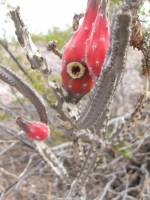Shrubs, low, erect to sprawling, arching, or scrambling, sparingly branched. Roots turnip-shaped or tuberlike and clustered. Stems unsegmented, gray, gray-green, greenish brown, brown, or purplish, columnar, proximally terete, distally terete or angled [or dimorphic with young stems 3-5-angled and adult stems terete in two Mexican species], [12-]25-300[-400] × 0.3-2[-6] cm, rigid, slender, canescent [or papillate]; ribs [3-]4-9[-20], often prominent, rib crests usually straight, uninterrupted; areoles (3.5-)5-20 mm apart along ribs, circular to elliptic, lanose or sometimes glabrate; areolar glands absent; cortex and pith not mucilaginous. Spines 5-15(-17) per areole, yellowish white, sometimes with black tips, conic, subulate with swollen bases, sometimes acicular to bristlelike, 1.5-4[-25] mm, puberulent to glabrate, scurfy; radial and central spines similar. Flowers nocturnal (remaining open next day), usually borne laterally along distal portions of ribs, at adaxial edges of areoles, usually fragrant, salverform with long tube flaring abruptly near apex, usually 7-25 cm; tepals lanceolate to oblanceolate, apiculate to attenuate; outer tepals greenish, usually tinged with red, purple, brown, or white, 25-50 × 2-6 mm, margins entire or minutely ciliate; inner tepals commonly white [or red], sometimes lightly tinged cream, rose, red, or green, 25-75 × 8-12 mm, margins entire to slightly undulate; ovary with low tubercles, minutely scaly or scaleless, spiny, areoles woolly; stigma lobes 9-12, white to yellow-white, 10-15 mm. Fruits indehiscent, red to scarlet [carmine to purple], pyriform or ellipsoid [to ovoid], [30-]40-90 × 25-50 mm, fleshy, low tuberculate, scaleless, spiny; pulp reddish, in some taxa sweet and edible; floral remnant persistent. Seeds black, broadly oblong, 1-4 × 0.8-2.5 mm, shiny or dull; testa rugose, pitted and/or with raised polygonal cells. x = 11.
PLANTS: Low, erect, arching or sprawling shrubs, 1-3 m tall, arising from l-many tuber-like roots.
STEM: simple to much branched, basally cylindric but distally with either obscure to prominent ribs or (in some Mexican species, dimorphic with young stems always conspicuously 3-8-winged, and with mature stems ribbed), papillose-pubescent when young, 0.5-3.5(-6.5) cm in diameter; ribs 3-9(-20), obscure to prominent.
LEAVES: linear-deltoid, ca. 1 mm long.
AREOLES: circular to elliptic, 1-8 mm in diameter, widely separated to nearly contiguous on rib.
SPINES: conic with swollen bases, subulate, sometimes bristle-like, 2-25 mm long.
FLOWERS: usually nocturnal, solitary, subterminal or lateral, perfect, actinomorphic (or floral tube curved), salverform but flaring abruptly near apex, mostly 8-25 cm long, 5-12 cm wide; ovary ovoid to ellipsoid, bearing low tubercles with woolly, spiny areoles; floral tube scaly usually bearing bristles in axils; inner tepals commonly white, sometimes lightly tinged cream, rose, red or green (bright red in one Mexican species), lanceolate, attenuate. Stamens many, exserted; style and the 9-12 stigma lobes white to yellow-white.
FRUITS: scarlet to carmine or purple, papillose-canescent to glabrate, spiny, obpyriform, ovoid to ellipsoid, 3-10.5 cm long, indehiscent; pulp reddish, fleshy.
SEEDS: numerous, black, rugose or tessellate, sometimes pitted, 1-4 mm long (in ours).
NOTES: Species ca. 20, deserts and dry tropical forests, sw U.S.; nc, wand s Mex. Delimitation of genus is debated: here to include Peniocereus, Neoevansia W. T. Marshall and Wilcoxia sensu Britton & Rose (excluding type species) but excludes Acanthocereus (Engelmann ex A. Berger) Britton & Rose and Nyctocereus (A. Berger) Britton & Rose. (Greek: penios = thread, referring to stem size + Cereus = an old generic name for columnar cacti). Sanchez-Mejorada, H. 1974. Revision del Genera Peniocereus (Las Cactaceas). Gobierno del Estado de Mexico, Direcci6n de Agricultura y Ganaderfa, Toluca, Mex. Sanchez-Mejorada, H. 1973. Cact. y Sue. Mex. 18: 13-27.
REFERENCES: Pinkava, Donald J. 1995. Cactaceae. J. Ariz. - Nev. Acad. Sci. 29(1): 2, 6










